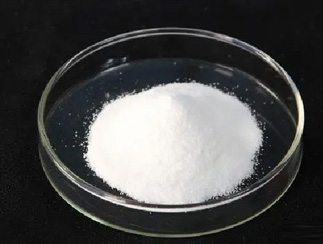Adipic acid CAS:124-04-9


Adipic acid CAS:124-04-9
CAS Number:124-04-9
Adipic acid, or more formally hexanedioic acid, is a white crystalline solid that melts at 152 oC. It is one of the most important monomers in the polymer industry.
Adipic acid is found in beet juice, but the article of commerce°™°÷2.5 million tonnes of it per year°™is manufactured. In 1906, French chemists L. Bouveault and R. Locquin reported that adipic acid can be produced by oxidizing cyclohexanol. Today, the most common manufacturing process is the nitric acid (HNO3) oxidation of a cyclohexanol®Ccyclohexanone mixture called KA (for ketone®Calcohol) oil.
Almost all adipic acid is used as a comonomer with hexamethylenediamine to produce nylon 6-6. It is also used to manufacture other polymers such as polyurethanes.
Using HNO3 to produce adipic acid has its downside: Copious amounts of nitrous oxide (N2O), a greenhouse gas, are coproduced and released into the atmosphere. In late 2014, K. C. Hwang and A. Sagadevan of National Tsing Hua University (Hsinchu City, Taiwan) reported a process that uses ozone and ultraviolet (UV) light to oxidize KA oil to adipic acid. This method eliminates the production of N2O; but before the process can be used commercially, problems associated with the formation of organic peroxides from ozone and the difficulty of using UV light on a large scale must be overcome.
English name:
| Hexanedioic acid |
| Adipic acid |
| 1,4-butanedicarboxylic acid |
| 1,6-hexanedioic acid |
| acide adipique |
| acifloctin |
| acinetten |
| adilactetten |
| adipate |
| adipinic acid |
| ai3-03700 |
| fema number 2011 |
| kyselina adipova |
| kyselina adipova (czech) |
| molten adipic acid |
| Adipic acid;1,4-Butanedicardicarboxylic acid;Dicarboxylic acid C6;Hexanedioic acid |
| ADI-PURE high purity adipic acid |
| adipic |
| adipicacid |
| oxo alcohol adipate |
| Adipins¶Ńure |
| Adipins¶Ńure(Tieftemperaturform) |
Adipic acid
CAS: 124-04-9
Adipic acid Property description:
Colorless crystal with a burnt bone odor.
Melting point 153 °ś, boiling point 332.7 °ś (decomposition at 101kPa),
relative density 1.360 (25/4 °ś), flash point (open cup) 209.85 °ś, flash
point (open cup) 231.85 °ś, melt viscosity 4.54mPa °§ s (160 °ś), flash
point 196 °ś. Slightly soluble in water (15 °ś, 1.44g/100ml), easily
soluble in most organic solvents such as alcohol and ether. Dissolve
160g in 100ml boiling water. The pH value of the 3% solution is 2.7.
Adipic acid Production method:
Adipic acid exists in sweet radish in nature.
In 1937, DuPont in the United States first achieved industrial
production of adipic acid by oxidizing cyclohexanol with nitric acid. In
the 1960s, the industry gradually switched to the cyclohexane oxidation
method, which first produced a mixture of cyclohexanone and
cyclohexanol as intermediate products (i.e. ketone alcohol oil, also
known as KA oil) from cyclohexane, and then carried out nitric acid or
air oxidation of KA oil. In the 1980s, research on adipic acid was
unprecedentedly active, with over 30 patents published in 1990. The raw
materials were expanded from cyclohexane to butadiene and cyclohexene,
and the production technology was already in the field of
electrochemistry. The nitric acid oxidation of KA oil method generally
uses an excess concentration of 50-60% nitric acid, which is carried out
in series through two-stage reactors. The catalyst used in the reaction
is copper vanadium system (copper 0.1-0.5%, vanadium 0.1-0.2%), with a
temperature of 60-80 °ś and a pressure of 0.1-0.4MPa. The yield is 92-96%
of the theoretical value. After distilling nitric acid from KA oil
oxidation products, high-purity adipic acid can be obtained through
two-stage crystallization refining. The air oxidation method uses copper
acetate and manganese acetate as catalysts, acetic acid as a solvent,
and air to directly oxidize KA oil. Generally, two-stage reactors are
connected in series: the first stage has a reaction temperature of
160-175 °ś, a pressure of 0.7MPa (gauge pressure), and a reaction time of
about 3 hours; The second stage reaction temperature is 80 °ś, the
pressure is 0.7MPa (gauge pressure), and the reaction time is about 3
hours. The oxidation product is refined through two-stage
crystallization, and the recovered solvent can be recycled after
treatment. The selectivity of this method is comparable to that of
nitric acid method, without the strong corrosion problem of nitric acid
method, but the reaction time is four times that of nitric acid method.
The adipic acid produced by air oxidation method cannot achieve fiber
grade purity. Therefore, this method is still rarely used. Other
production methods for adipic acid include chlorocyclohexane method,
recovery of adipic acid from by-products of cyclohexane oxidation, and
preparation of adipic acid from acrylic esters. Asahi Kasei Corporation
in Japan also conducted research on one-step air oxidation of
cyclohexane to produce adipic acid. Product specifications: The
industrial product has a white crystalline or powdery appearance, with a
first grade content of °› 99.5% and a melting point of 151-153 °ś;
Secondary product content °› 99.0%, melting point 150-154 °ś. Raw material
consumption quota: 740kg/t cyclohexanol (or KA oil), 908kg/t nitric
acid (calculated as 100%), 0.2kg/t copper, and 0.1kg/t vanadium
(calculated as V2O5).
Adipic acid Usage:
Mainly used as a raw material for nylon 66 and engineering plastics. Secondly, it is used for the production of various ester products, as plasticizers and advanced lubricants. In addition, adipic acid is also used as a raw material for polyurethane elastomers and as an acidifying agent for various foods and beverages, sometimes surpassing citric acid and tartaric acid. Adipic acid is also a raw material for pharmaceuticals, yeast purification, insecticides, adhesives, synthetic leather, synthetic dyes, and fragrances




































Wechat:Customer
